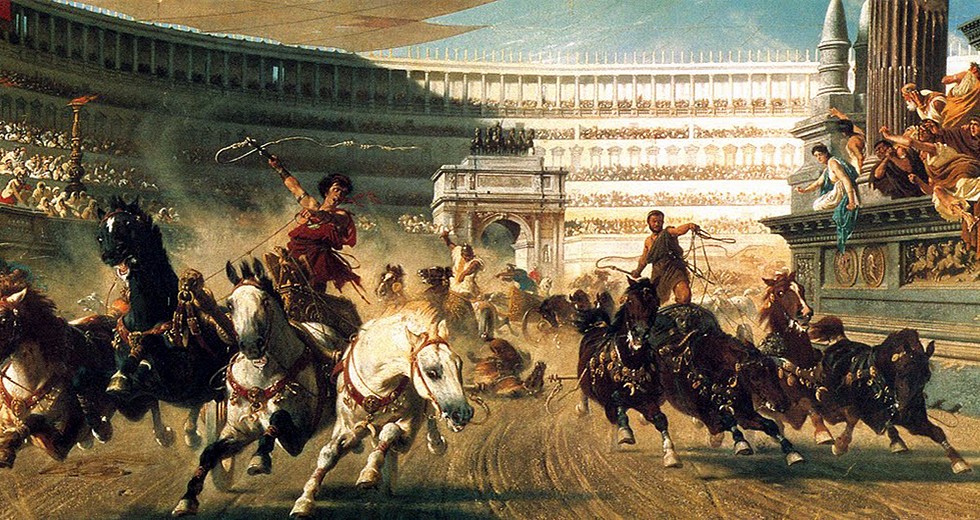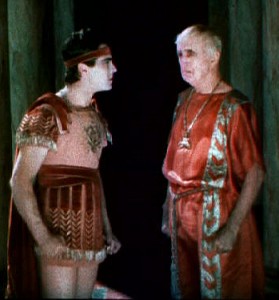
In the annals of cinema history, few films have been as epic as the 1925 silent classic “Ben-Hur: A Tale of the Christ.” Based on Lew Wallace’s 1880 best-selling novel, the movie had the proverbial cast of thousands, with more than 125,000 actors recruited for the shoot. The most expensive silent film ever made, it almost bankrupted its studio, MGM, which inherited the production when it merged with Goldwyn Pictures in 1924. Originally billed as “The Film Every Christian Should See,” “Ben-Hur” manages to balance solemn reverence with grand spectacle.
Performing a score by composer-drummer Stewart Copeland, the Chicago Symphony Orchestra will present “Ben-Hur” in an SCP Special Concert on Oct. 14. Copeland on drums will join the CSO, under conductor Richard Kaufman. Copeland and Kaufman also will give a pre-concert lecture beginning at 6:30 p.m. in the Grainger Ballroom.
As the chariots approach the starting gate, here are some fun “Ben-Hur” facts to consider:
1. Moved from Babylonia: With Italian locales sitting in for the Holy Land, “Ben-Hur” began shooting around Rome. As filming stretched on for almost two years, seemingly out of control, studio chiefs stopped production and recalled the crew back to California, under the supervision of MGM whiz Irving Thalberg.
2. Faces in the crowd: Dozens of film stars, already established and soon-to-be so, served as extras in the chariot race scenes, including John Barrymore, Lionel Barrymore, Gary Cooper, Joan Crawford, Marion Davies, Douglas Fairbanks Sr., Clark Gable, John Gilbert, Lillian Gish, Harold Lloyd, Myrna Loy, Colleen Moore and Mary Pickford. Worried that the film’s pulchritude factor was too low, “Ben-Hur” producers also asked filmmaker Mack Sennett to lend his famed “Bathing Beauties” — which included budding starlets Janet Gaynor, Carole Lombard and Fay Wray — to the cause.
3. Double duty: One of the film’s young assistant directors was William Wyler, then 22. Over his long career, he went on to receive three best director Oscars, including one for the 1959 remake of “Ben-Hur.” Though initially reluctant about directing the remake, he later admitted: “I thought that this picture would make lots of money, and you know, maybe I’ll get some of it. Which I did!”
4. In living color: Though primarily shot in black and white, the film features several sequences in the early two-strip Technicolor process. All of the scenes that depict Jesus, or refer to him, including his birth and the Last Supper, were filmed in color, along with Ben-Hur’s entrance into Rome.
5. Visions of light: Because he disliked the idea of having Jesus portrayed onstage, Lew Wallace had rejected requests to turn his book into a play. He finally changed his mind when someone suggested the use of a shaft of light, instead of an actual actor, to portray the savior onstage. This treatment was carried over to the film, which reveals his hands, arms and feet but never his face.
6. Racing in the streets: The famous chariot scene was staged at the intersection of what would become LaCienega and Venice boulevards, then mere dirt paths, in Los Angeles.
7. A star is born: After an eight-year run of mostly supporting roles, Ramon Novarro, born in Durango, Mexico, made his breakthrough in “Ben-Hur,” and thus became the first Latino actor to achieve Hollywood stardom. He was also deeply closeted, according to Allan Ellenberger, author of Ramon Novarro: A Biography of the Silent Film Idol. “He was very religious, perhaps too much so, and this in some ways was the cause of many of his problems,” he said. “Being gay and religious created an inner turmoil that eventually drove him to alcohol at any early age.”
8. International man of mystery: Lew Wallace, author of Ben-Hur, lived an epic life. Born in Brookville, Ind., he was the son of an Indiana governor. Eventually a statesman in his own right, Lew became a lawyer, served as a Civil War general, presided over the Andersonville military trial, was named an ambassador to the Ottoman Empire and was appointed governor of the New Mexico Territory, where he put a bounty on the head of notorious outlaw Billy the Kid. According to a fascinating article published last year on Slate, Wallace was moved to write Ben-Hur after a lengthy train-car discussion with noted atheist Robert Ingersoll.
9. See it now: A chariot from this movie is part of the permanent collection of the Museum of the Moving Image in Astoria, Queens, N.Y.
10. More passions of the Christ: Producer Mark Burnett and producing partner/wife Roma Downey have teamed up with Paramount/MGM for yet another remake of “Ben-Hur,” with a tentative release date set for Feb. 26, 2016. Directing will be Timur Bekmambetov, best known for “Abraham Lincoln, Vampire Hunter” (2012). (Insert joke here.)
Sources: The Internet Movie Database, Ben-Hur.com, Kevin Brownlow’s “The Parade’s Gone By,” Slate.com.
PHOTO: Alexander von Wagner’s Chariot Race, completed in 1882 just two years after the publication of Ben-Hur, depicts a contest in the Circus Maximus of ancient Rome. After being exhibited at the Vienna Exposition, the painting was expanded to a larger size for the 1893 World’s Columbian Exposition in Chicago.








